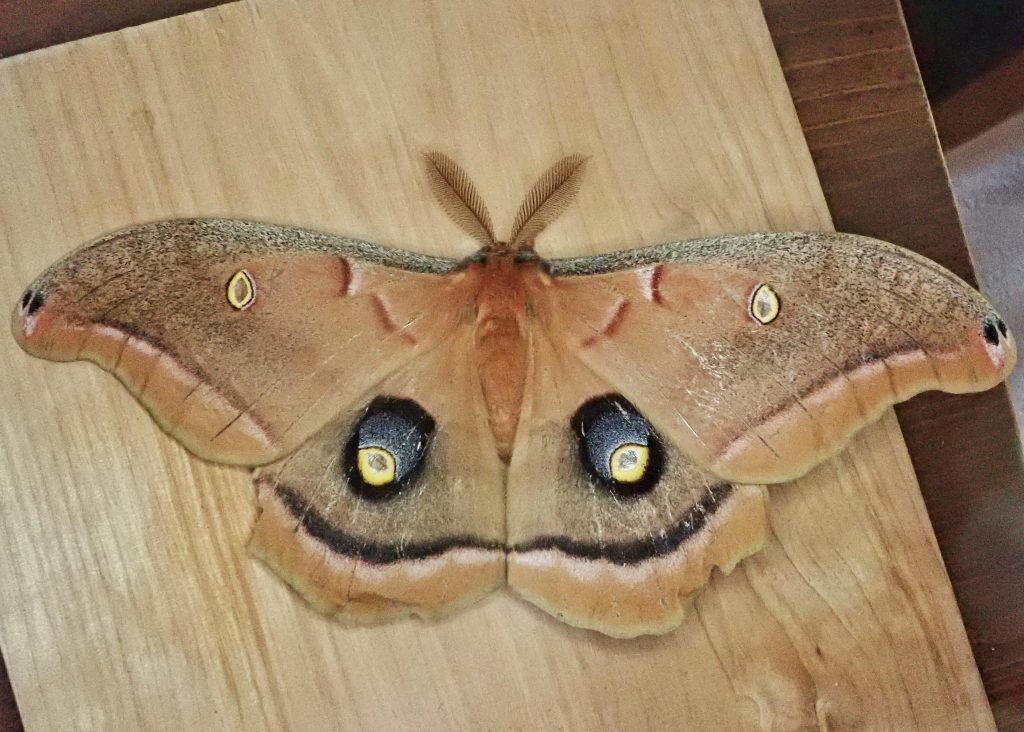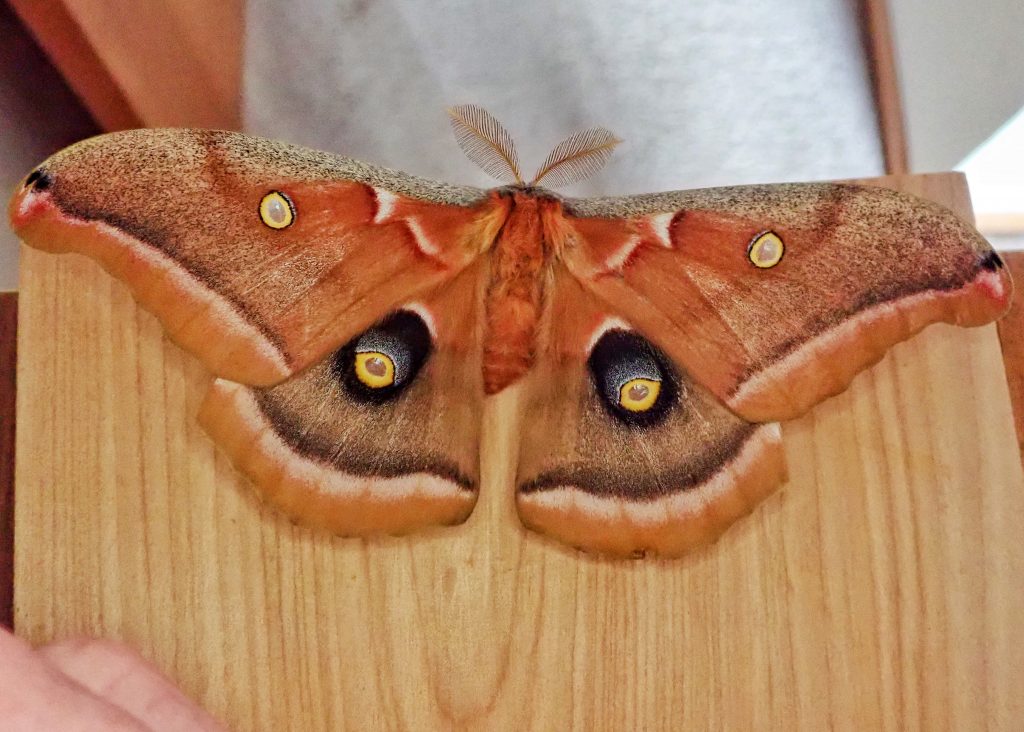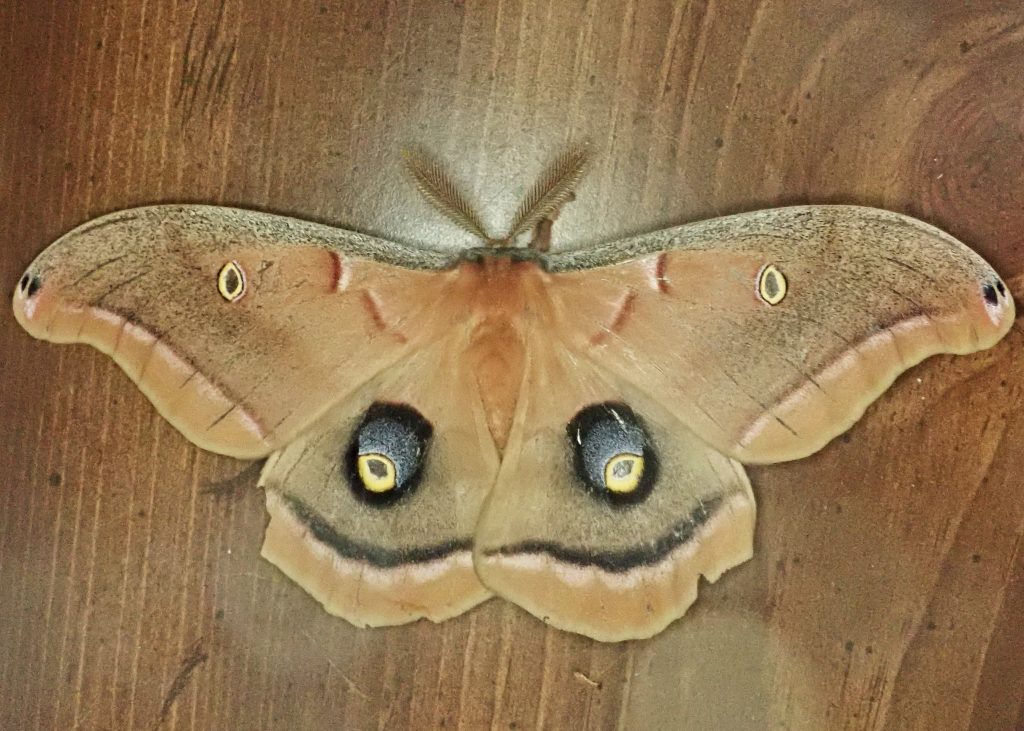
The Polyphemus Moth has a wingspan of up to 6 1/2”, the largest wingspan of any moth in the PNW, although the largest one I’ve found ‘only’ measured a little over 5 1/2”. With its large size, tan ground color, and transparent eyespots it isn’t likely to be confused with any other moth in our region. It is said to be common in woodlands and damp forested areas, but in my year-and-a-half of mothing I’ve only seen 4. But each one is a golden memory etched upon my mind, a mixture of joy, awe, and gratitude. The first time I saw one my initial knowledge of it came when a huge shadow appeared on my mothing sheets. I took it to be a bat, an interesting happening in its own right. Then I saw the broad expanse of warm tan wing and breathed a soft ‘thank you’, to what I do not know.
The name Polyphemus comes from the Greek myths about the giant, cyclopean Polyphemus, son of Poseidon and Thoosa, in reference to the single eyespot on each wing, which probably serves to redirect bird strikes to these less biologically critical areas.
Though they are not reared for this purpose commercially, Polyphemus Moths are silk moths, and silk can be made from their cocoons, as shown here.

Polyphemus Moths utilize many different larval hosts, including (but not limited to) oak, willow, maple, alder, birch and shrubs and trees in the Rosaceae family. They can even be an agricultural pest, with occasional large outbreaks in filbert orchards. The caterpillars are leaf eaters and, despite the wide variety of leaves they will feed on, strongly prefer to stick with the species of leaves they start with. These caterpillars are known to be particularly voracious, eating up to 1,500 times their body mass daily! This would equate to eating roughly 2 cubic feet of oak leaves as a caterpillar. The adults, however, do not feed, having only vestigial mouthparts. My friend Mathew Campbell, who rears Lepidoptera for a living, says that the leps that don’t feed as adults typically eat far more as larvae.
Polyphemus Moths can be found region wide wherever there are larval hosts, which only excludes the most arid parts of the interior, and they have adapted to landscape plantings in urban areas. They fly from early May to late July.

http://entnemdept.ufl.edu/creatures/MISC/MOTHS/polyphemus_moth.htm
https://animaldiversity.org/accounts/Antheraea_polyphemus/
Size- FW length 44-68mm
Habitat- Woodlands, mesic forests; wherever larval hosts can be found
Range- Region wide except for the most arid parts of the interior
Eats- Larvae eat leaves of, amongst others, oak, willow, maple, alder, birch, and shrubs and trees in the Rosaceae family. Adults do not feed
Flight Season- May to July

This is fascinating — thank you!
You are welcome!
They are so gorgeous! A huge one showed up on the front porch of our home on top of Finn Hill in Kirkland, WA – we were amazed. Only time to see one.
My 5year old daughter found one in the stairwell of our apartment complex today. We didn’t have a clue what it was, but we carefully got it outside. We live in Bismarck, ND and we found it on June 2nd 2023. If they are often found in PNW it might be lost.
Very cool find, Jean! I’ll bet your daughter was excited! They are found throughout North America wherever their larval hosts are, and those hosts include maples, oaks, birch, alder, willows, and a few more. Thanks for sharing that with us!
Found one this morning, injured on my lawn in Hebron, Maine! About as East as you can get. Upon returning, it was gone. I figure bird food. Very beautiful with coloration just like the 2nd to last photo in the article, maybe 5+ inches wingspan. Should have taken a photo. Not just the Pacific Northwest.
Found one of these beauty’s today in Lindsay Ontario Canada’ day after a big storm
I’ve never seen one before said my 70 year old mother !
Very cool, Bradley!
These were regular visitors when I lived in Vermont – I’m happy to see I might have hopes of seeing one here in the PNW as well! Just happened upon and love your site!
I hope you see some too! Thanks for your appreciation!
One of these crashed into the side of my neck while taking out the trash and scared the crap out of me, until I saw what it was. Its pretty cool looking. I admired it and took a pic of it then it began “shivering” which I learned was to regulate it’s body heat. It’s ironic because it landed on the packaging from a space heater right where it said something about temp. Control, and also because I live in South West Florida. It’s not cold here too often. Not sure where it came from, I’ve never seen one before now. I’m trying to avoid convincing myself that it’s some sort of sign or omen. The eyes on its wings seem a bit ominous.
Thanks for sharing that story with us, Chelsea!